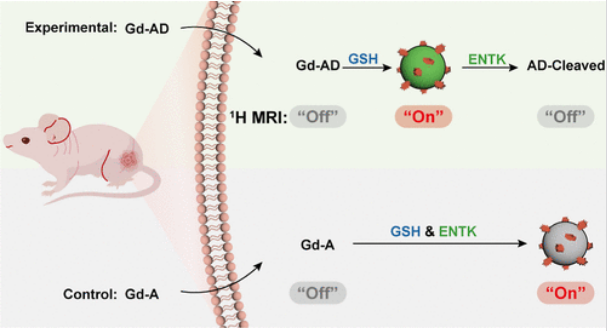
东南大学梁高林团队近日实现了在肿瘤中显示体内“装配-拆卸”级联的“开关-关闭”磁共振成像信号。相关论文发表在2025年6月24日出版的《美国化学会杂志》上。
“组装-拆卸”级联已被用作肿瘤治疗的一种高效方法,但其实时体内监测仍然具有挑战性。目前的策略面临着渗透深度和实时性之间的基本权衡,而目前还没有关于将这两种特征整合在一起以在活生物体中显示这种动态级联的报道。
研究组开发了一种钆(Gd)探针Cys(StBu)-Asp-Asp-Asp-Asp-Lys-Lys(DOTA(Gd))-CBT (Gd-AD),通过T1加权“Off-On-Off”1H磁共振成像(MRI)信号显示体内的“组装-拆卸”级联。在还原条件下,Gd-AD通过CBT-Cys点击反应组装成Gd纳米颗粒,细胞和肿瘤中的1H MRI信号分别增强59.3%和25.4%(“Off-On”)。
在肠激酶(ENTK)切割后,纳米颗粒解体,导致细胞和肿瘤中的1H MRI信号分别下降23.4%和15.2%(“On-Off”)。研究组设计并研究了一种响应还原和ENTK组装成Gd纳米颗粒的混杂控制探针Asp-Asp-Asp-Asp-Lys-Cys(StBu)-Lys(DOTA(Gd))-CBT (Gd-A),该探针具有“关闭”1H MRI信号。在1 h肿瘤成像时,Gd- a仅显示“Off-On”1H MRI信号,而Gd- ad清晰显示“Off-On-Off”信号,反映Gd纳米颗粒在肿瘤内的“组装-拆卸”级联。研究组期望他们的实时显示体内“组装-拆卸”级联的策略可以在不久的将来帮助人们优化基于纳米药物的肿瘤治疗方法。
附:英文原文
Title: Displaying In Vivo “Assembly–Disassembly” Cascade with “Off–On–Off” Magnetic Resonance Imaging Signals in Tumor
Author: Hai-Dong Xu, Xianbao Sun, Zheng Huang, Xiaotong Cheng, Xiancheng Fu, Jiayu Li, Ziwen Wei, Junchao Qian, Gaolin Liang
Issue&Volume: June 24, 2025
Abstract: “Assembly–Disassembly” cascade has been utilized as a highly effective approach for tumor theranostics, but its real-time in vivo monitoring remains challenging. Current strategies face a fundamental trade-off between penetration depth and real-time nature, while there is still no report on integrating both features to display this dynamic cascade in a living organism. In this work, we develop a gadolinium (Gd) probe Cys(StBu)-Asp-Asp-Asp-Asp-Lys-Lys(DOTA(Gd))-CBT (Gd-AD) to display an in vivo “Assembly–Disassembly” cascade via T1-weighted “Off–On–Off” 1H magnetic resonance imaging (MRI) signals. Under reduction conditions, Gd-AD undergoes a CBT-Cys click reaction to assemble into a Gd nanoparticle, with enhanced 1H MRI signals of 59.3% and 25.4% in cells and in tumors, respectively (“Off–On”). Upon enterokinase (ENTK) cleavage, the nanoparticle disassembles, rendering decreased 1H MRI signals of 23.4% and 15.2% in cells and in tumors, respectively (“On–Off”). A scrambled control probe Asp-Asp-Asp-Asp-Lys-Cys(StBu)-Lys(DOTA(Gd))-CBT (Gd-A), which responds to reduction and ENTK to assemble into a Gd nanoparticle with “Off–On” 1H MRI signals, is designed and studied in parallel. During 1 h tumor imaging, while Gd-A only displays “Off–On” 1H MRI signals, Gd-AD clearly shows “Off–On–Off” signals to reflect the “Assembly–Disassembly” cascade of Gd nanoparticles in tumor. We expect that our strategy of real-time display of in vivo “Assembly–Disassembly” cascade could help people to optimize their nanodrug-based tumor theranostics in the near future.
DOI: 10.1021/jacs.5c06634
Source: https://pubs.acs.org/doi/abs/10.1021/jacs.5c06634
JACS:《美国化学会志》,创刊于1879年。隶属于美国化学会,最新IF:16.383
官方网址:https://pubs.acs.org/journal/jacsat
投稿链接:https://acsparagonplus.acs.org/psweb/loginForm?code=1000
